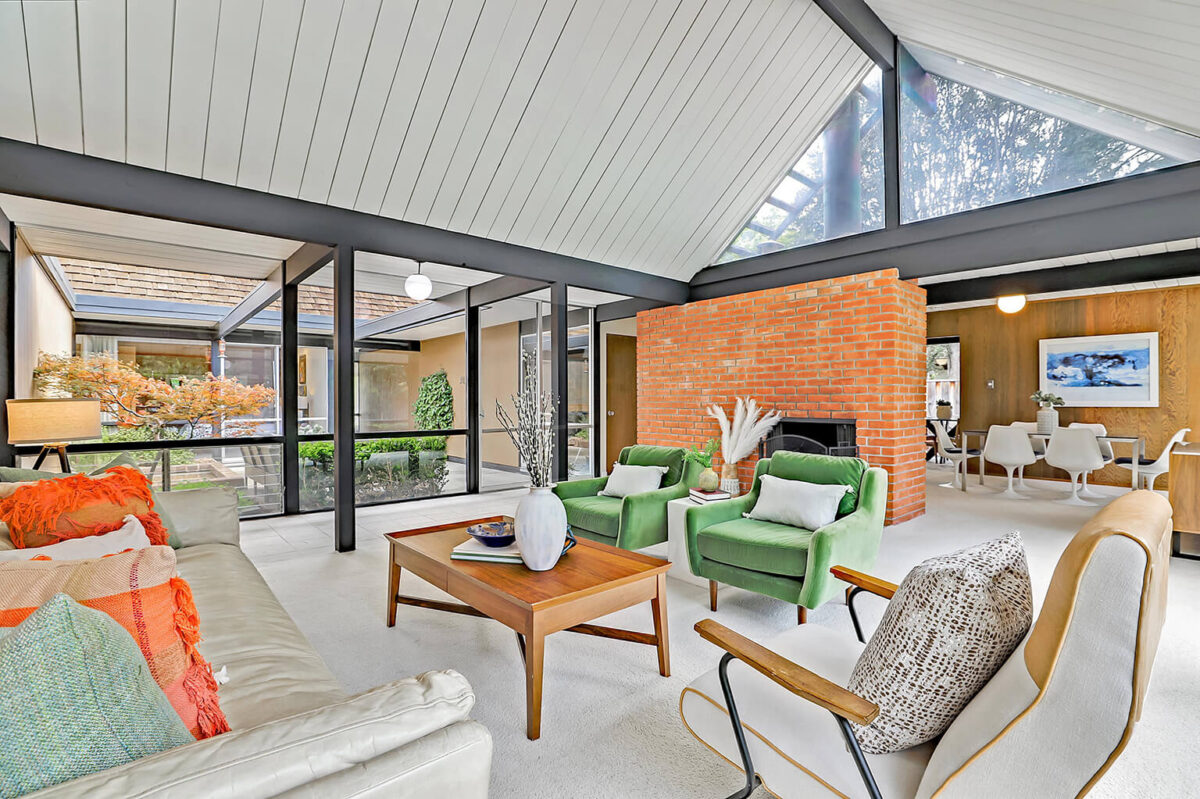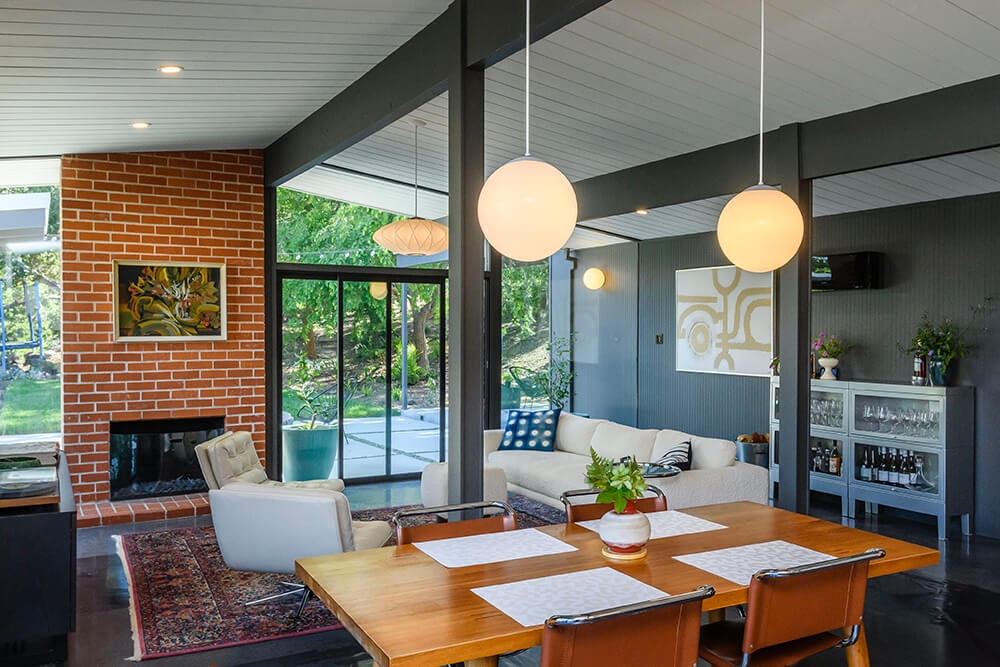Words by Loureen Murphy
As Monique Anton drove down a Sunnyvale street in 2009, passing dozens of flat-roofed, plain-faced homes, curiosity grabbed the wheel and pulled her over. “What is this?” she asked the first person she saw. “It was like a portal I walked through and came out in a completely other world.” The world of Eichlers—which launched a journey of discovery.
“I fell in love with them, just like I fell in love with my husband,” recounts Monique, the broker and CEO of Modern Homes Realty, a Menlo Park agency specializing in Mid-Century Modern (MCM) properties. The street? Joseph Eichler’s first development, dated 1949.
From 1949 to 1966, the renowned real estate developer built over 11,000 Eichler homes in California, with the vast majority in the Bay Area. Today, Eichler housing tracts, along with custom homes, still pepper Peninsula communities including Palo Alto, Menlo Park, Redwood City, Atherton, Burlingame, Hillsborough, Portola Valley, Foster City and San Mateo. With signature open floor plans and floor-to-ceiling glass, Eichlers have come to epitomize indoor-outdoor living, an enduring concept that evolves with each generation of homeowners.
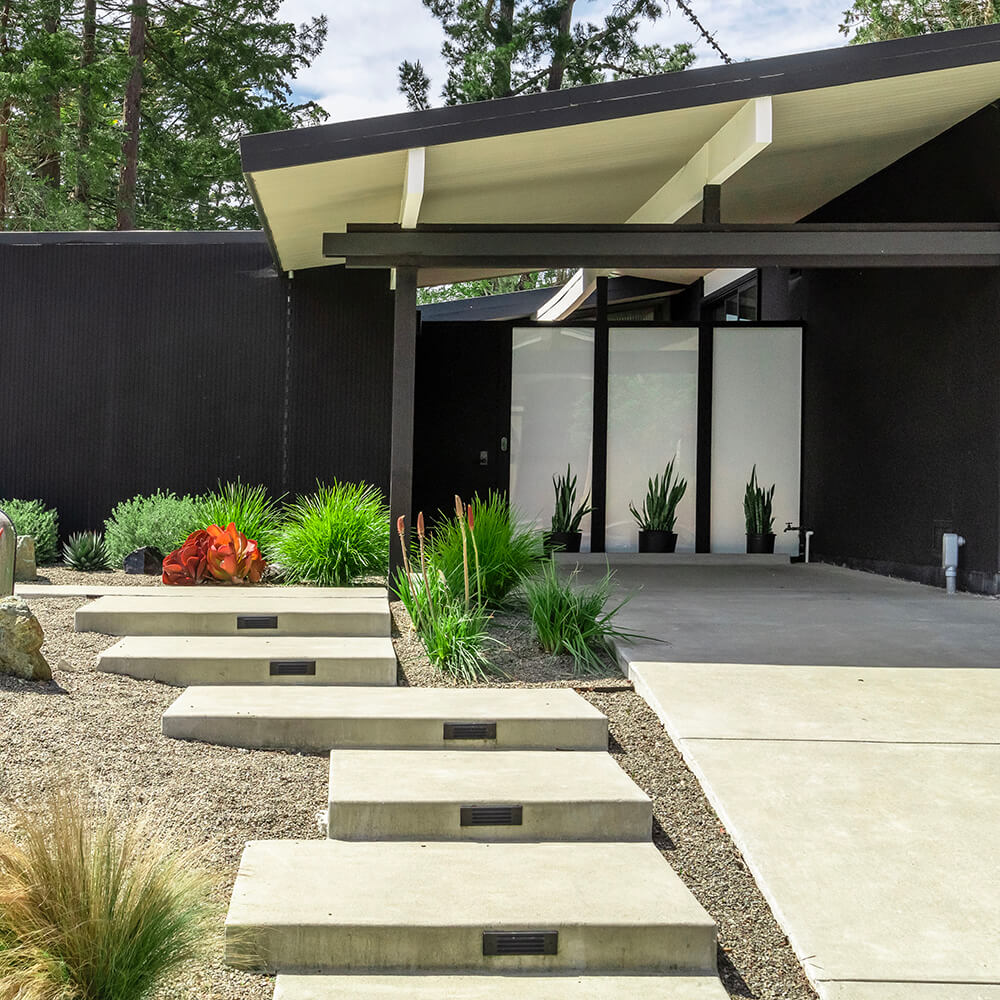
The Essence of Eichler
Just as Monique’s Sunnyvale drive altered her course, so a single move changed Joseph Eichler’s life trajectory. From 1943-1945, Eichler and his family rented the Hillsborough home that Frank Lloyd Wright designed for Sidney Bazet. Its clean lines, light-filled rooms, radiant heating and indoor-outdoor flow inspired Eichler’s 1949 launch of the Sunnyvale Building Company, which envisioned innovative-yet-affordable suburban homes. Soon, Eichler properties sprouted among South Bay and Peninsula orchards and hills, and beyond.
“Why buy a ‘Model T’ home when you can get so much house for so little!” enticed a 1951 Eichler ad. Photo-laced articles and ads boosted sales of these intentionally middle-class “California Modern” dwellings, as each year brought larger floor plans and more design enhancements.
SIGNATURE EICHLER FEATURES + Exposed posts and beams + Globe lights + Skylights + Home level with the ground, no steps up + Natural, accessible materials: wood, steel, concrete + Mahogany paneling + Formica counters in kitchens and baths + Open floor plans in the common areas + Radiant heat, coiled pipes in concrete slabs, warmth from the floor up + Floor-to-ceiling glass walls + Cork flooring + Atriums in some models + A-framed roofs + Clean lines
Eyesore or Eden?
Heather Rarden lives in San Mateo Highlands, Eichler’s largest subdivision. “When I first started dating [my husband] Mark,” she recalls, “he brought me here and said, ‘This is a very special neighborhood.’” Um. No. The “boring look from the front—straight lines, flat roofs” echoed the small, dark Navy base houses Heather had grown up in. But the “unassuming” facade of Mark’s childhood home opened to a much “more expansive feeling inside.”
Hesitant to make the move, Heather studied vintage magazines to understand the idea behind Eichler’s designs. It worked. And, once she and Mark cleared out the overgrowth in the backyard, their house seemed to double in size.
Architect and Burlingame Eichler owner Kristen Bergman agrees that Eichlers “don’t face the street particularly well.” Some homeowners opt to fence over the front or alter it in some way. Others dislike the dark entrance that draws the eye straight to the backyard. Yet when Kristen entered her first Eichler, she couldn’t “believe how beautiful that house was,” marveling, “Oh, this is what a house can be.” That vision later sparked the purchase and remodel of her own Eichler.
In Palo Alto’s Charleston Meadows, new Eichler owners Arthur and Tina say they “like the idea of indoor-outdoor living, with lots of windows and skylights and natural light.” And the open floor plan keeps kids from “being holed up in their rooms.” Just north in the Palo Verde neighborhood, Katie Renati still delights in her floor-to-ceiling window walls after 26 years. “I wake up and I see the greenery outside,” she beams. “I don’t think I could live in a normal house again.” Monique sums up Eichlers’ allure—“They’re like little zen pods.”
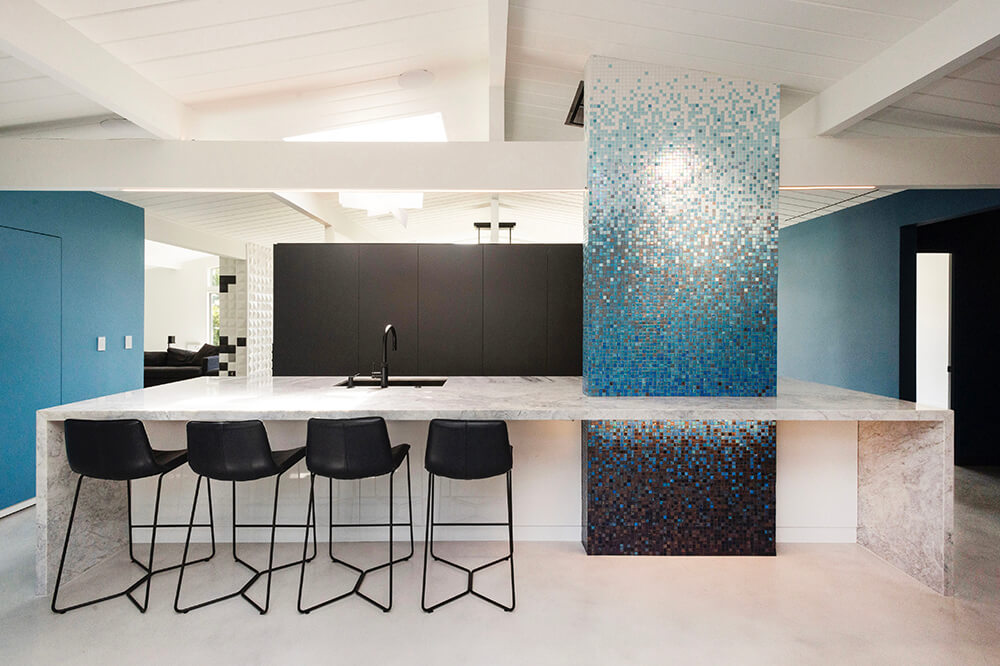
Neighborhood Nexus
Eichler enthusiasts tout community. In Katie’s cohesive neighborhood, she enjoys daily conversations, decades-long friendships and regular block parties. People often gather at Palo Alto’s Eichler Swim and Tennis Club, where Joe Eichler himself cut the ribbon on opening day in 1958. The neighbors whom Arthur and Tina met at an open house factored into their buying decision. “They were all really nice! We also liked that there were a lot of kids the same ages as our kids,” Tina says.
The “convivial spirit is part of that fabric woven together in terms of indoor-outdoor,” Mark Rarden explains. “You’re constantly living with and around other people.” Modest-sized homes mean the sidewalks brim with “very active walkers, continuously running into each other,” he adds. Ubiquitous well-furnished patios become just an extension of your house for friends dropping by.
In any “Eichlerville,” social bonds strengthen over simple interactions, like sharing sources for door knobs and globe lights. Monique calls the MCM home connection a “club you buy into.” Infused with a sense of connection and identity, Eichler communities gather informally as well as holding annual events, such as home tours and holiday celebrations. Heather and Mark say they looked all over the Bay Area for that neighborhood feel. In the end, they found it right where Mark grew up.
EICHLER - DID YOU KNOW? + Apple co-founder Steve Wozniak grew up in an Eichler. + Atherton and Hillsborough boast a handful of the largest, most creative Eichler homes. + Some Eichler designs are one-offs, customized for an end lot after the rest of the tract was built out. + Palo Alto, home to Eichler Homes’ headquarters, holds the record for the city with the most of these iconic houses at 2,700. + The largest contiguous Eichler grouping, 700 homes, was built in San Mateo’s Highlands between the mid-1950s and mid-1960s. Bigger lots there allowed construction of some Super Eichlers. + Two of Palo Alto’s Eichler neighborhoods, Green Gables and Greenmeadow, are listed in the National Register of Historic Places. + At least 20 California developers imitated Eichler designs.
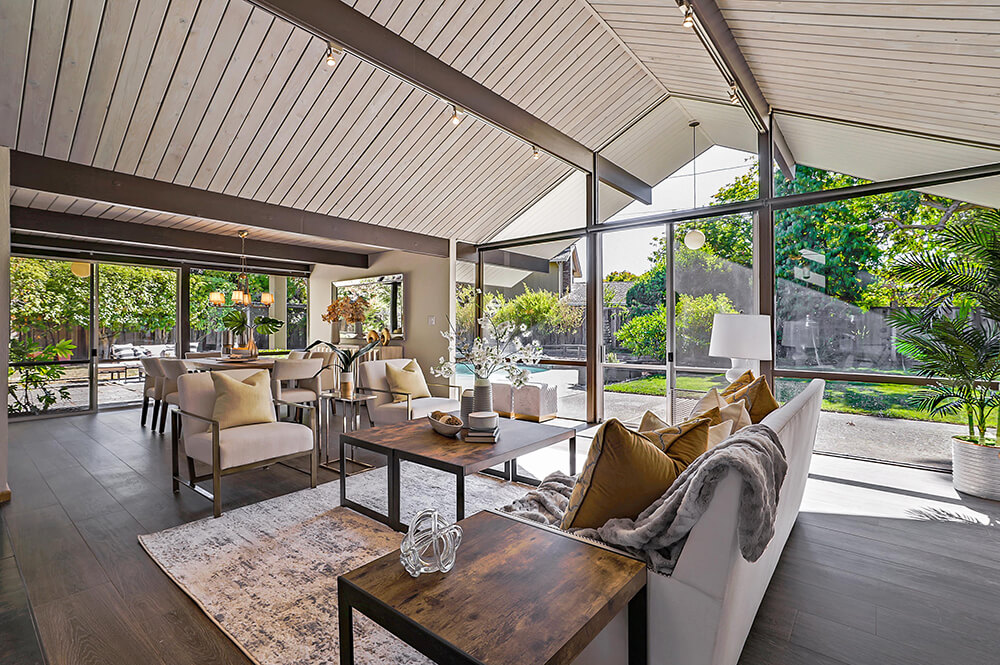
Purism, Practicality and Preservation
These concepts may collide or cooperate—and invariably arise in the never-neutral discussion of Eichlers among neighbors and professionals. “I have seen some unbelievable Eichlers that are totally untouched,” says Monique, an Eichler purist. “People pass them down from generation to generation.”
But sometimes remodels must happen. Roofs deteriorate. Radiant heating fails. Appliances fizzle. Amidst re-dos, vintage adherents will preserve the formica in the kitchen and bath and acquire components for old fixtures and appliances. But new materials complementing and supporting Eichler essence and efficiency can also bring peace to the purist. Even retractable roofs over open-air atriums can harmonize without compromising an Eichler’s architectural integrity, observes Monique.
Mark and Heather considered changes to his childhood home before they moved in. Youthful recollections gave him “a cheat sheet” to start. For example, a house with that much glass “gets really cold or really hot.” They examined the “great for ’58” construction and updated it with double-pane windows and slim blinds to mute bright light and reduce interior temps. Count them fans of the “modern technologies that make these kinds of homes even more beautiful to live in.”
Likewise, “committed modernist” Kristen fuses past and present in her Eichler remodels, where practicality supersedes the “time capsule.” Instead she asks, “What would Eichler and the architects who worked for him do today?” In her own 2,400-square-foot Super Eichler, she swapped the radiant heat system for new radiant heat while retaining the ground-to-roof glass, essential to a seamless indoor-outdoor experience.
Kristen notes that the most common renovation is to open up original enclosed galley kitchens to the rest of the communal space and replace appliances with more efficient ones. She creates pockets for a bit of personal solitude in the common area. Other popular additions include a powder room, storage near the entry point, built-ins and expanded lighting options.
Whether renovating while honoring design intent, or treasuring original paneling and fixtures, many homeowners work to perpetuate the Eichler legacy. Safeguarding the aesthetic look reaches beyond the glassy walls of individual homes. Many Eichler enthusiasts seek to keep the authentic feel to their streets, preventing “McMansions” that tower over neighboring rooftops, blocking light, creating shadows and visual discord.
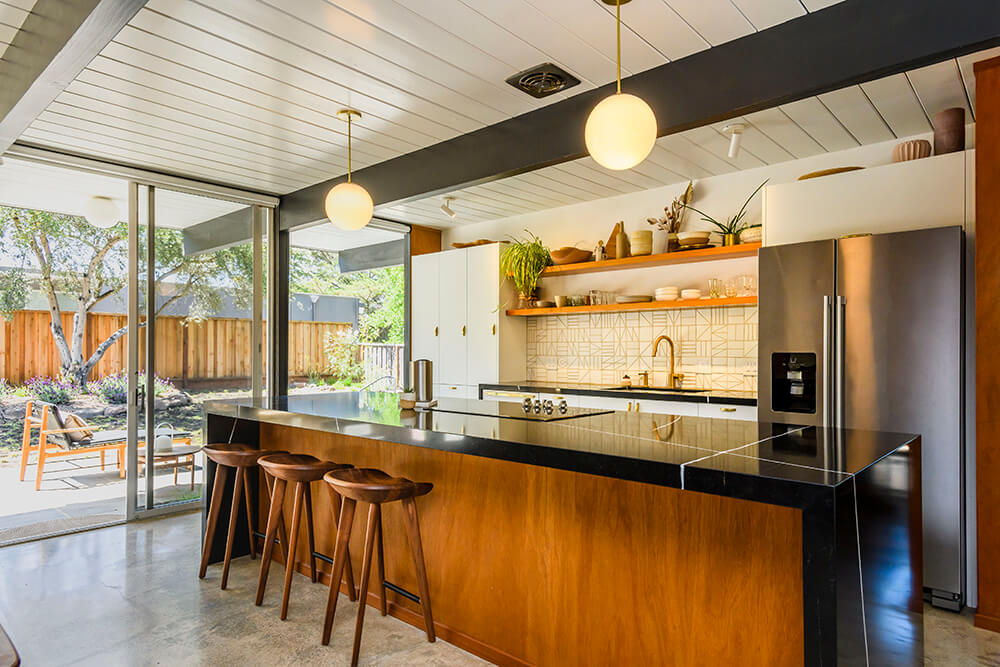
All-In with Eichlers
The Eichler Home Tour, staged five times since 2007, most recently showcased 12 Eichlers in San Mateo Highlands for its October 2023 event. Local Mid-Century Modern fans eagerly anticipate this rare-access opportunity and the chance to ask builders, architects and designers renovation and remodeling questions.
Now known as the “Eichler Lady,” Monique hosted the kick-off VIP party for the 2023 Eichler Home Tour. After founding Modern Homes Realty in 2012, she continued to go all-in with MCM. She even poured her ample knowledge into a 2019 documentary, People in Glass Houses: The Legacy of Joseph Eichler, sharing history, ideology and the growing yen for MCM vibes. Her weekly podcast, “Mid-Century Modernism with Monique,” hosts guest speakers ranging from architectural historians to journalists and interior designers.
Eichler homes’ leitmotif—simplicity with proximity to nature and neighbors—often elicits the designation “dream home” from owners. They see Eichlers as personal havens offering daily space for breathing deeply, imagining and reframing life. “When I discovered Eichlers,” Monique reflects, “I found more of myself.”


